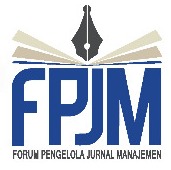Testing marketing expenses role on the relation between leverage and performance
Abstract
Marketing expenses usually one of the most important costs for the companies, but still a few research in finance discussing this. The previous study still inconsistent about the role of marketing expenses as a moderator or mediator between the effects of leverage on financial performance. This research intended to empirically test on that subject. This research is using 1792 panel financial report data taken from 256 companies listed in Indonesian Stock Exchange during 2010-2016. There are three main variables in this research: a performance that measures using returns on assets (ROA), marketing expenses are measures using the natural logarithm of marketing expenses. Leverage is calculated using total debt per total asset. Data is analyzed using panel data regression. The results show that marketing expense is a moderator but not a mediator variable in the effect of leverage on financial performance. Marketing expense moderates negatively the relationship between financial leverage on ROA. This is consistent with strategic management using Resources Advantage Theory and Du Pont Business Model.
JEL Classification: G32, M31
Keywords
Full Text:
PDFReferences
Akdogan, M. S. & Durak, A. (2016). Logistic and marketing performances of logistics companies: A comparison between Germany and Turkey. Procedia – Social and Behavioral Sciences, 235, 576-486. https://doi.org/10.1016/j.sbspro.2016.11.084
Al-Surmi, A., Cao, G, & Duan, Y. (2019). The impact of aligning business, IT, and marketing strategies on firm performance. Industrial Marketing Management. https://doi.org/10.1016/j.indmarman.2019.04.002
Bae, J., Kim, S., & Oh, H. (2016). Taming polysemous signals: The role of marketing intensity on the relationship between financial leverage and firm performance. Review of Financial Economics, 33(1), 29-40. http://dx.doi.org/10.1016/j.rfe.2016.12.002
Barney, J. B. (2001). Resources-based theories of competitive advantage: A ten year retrospective on the resource-based view. Journal of Management, 27(6), 643-650.
https://doi.org/10.1016/s0149-2063(01)00115-5
Baron, R. M., & Kenny, D. A. (1986). The moderator-mediator variable distinction in social psychological research: Conceptual, strategic and statistical considerations. Journal of Personality and Social Psychology, 51(6), 1173-1182. https://doi.org/10.1037//0022-3514.51.6.1173
Blumenthal, R. G. (1998). This the gift to be simple: Why the 80-year-old Du Pont model still has fans. CFO Magazine, January, 1-3.
Cacciolatti, L., & Soo, H. L. (2016). Revisiting the relationship between marketing capabilities and firm performance: the moderating role of marketing orientation, marketing strategy and organisational power. Journal of Business Research, 69(12), 5597-5610. http://dx.doi.org/10.1016/j.jbusres.2016.03.067
Cheng, L. T. W., Chan, R. Y. K., & Leung, T. Y. (2018). Impact of perk expenditures and marketing expenditures on corporate performance in China: The moderating role of political connections. Journal of Business Research, 86, 83-95. https://doi.org/10.1016/j.jbusres.2018.01.046
Februansyah, R. & Yanuarti, I. (2017). Pengaruh financial leverage terhadap financial performance pada sektor industri manufaktur yang terdaftar di Bursa Efek Indonesia (BEI) Periode 2015. Jurnal Ilmu Manajemen, 9(2). https://doi.org/10.31937/manajemen.v9i2.719
Fischer, M. & Himme, A. (2016). The financial brand value chain: How brand investments contribute to the financial health of firms. International Journal of Research in Marketing. http://dx.doi.org/10.1016/j.ijresmar.2016.05.004
Gyan, A. K., Brahmana, R., Karim, B. A. (2017). Diversification Strategy, Efficiency, and Firm Performance: Insight from emerging market. Research in International Business and Finance. http://dx.doi.org/doi:10.1016/j.ribaf.2017.07.045
Hanssens, D. M., Wang, F., & Zhang, X. P. (2016). Performance growth and opportunistic spending. International Journal of Marketing. http://dx.doi.org/10.1016/j.ijresmar.2016.01.008
Hasan, Z., & Ali, N. A. (2015). The impact of green strategy on firm’s performance in Malaysia. Procedia-Social and Behavioral Sciences, 172, 463-470. https://doi.org/10.1016/j.sbspro.2015.01.382
Hirunyawipada, T., & Xiong, G. (2018). Corporate environmental commitment and financial performance: Moderating effects of marketing and operations capabilities. Journal of Business Research, 86, 22-31. https://doi.org/10.1016/j.jbusres.2018.01.002
Hunt, S. D., & Morgan, R. M. (2005). The resources-advantage theory of competition. Review in Marketing Research, 153-205. http://dx.doi.org/10.1108/S1548-6435(2004)0000001008
Hunt, S. D. (2012). The evolution of resource-advantage theory: six events, six realizations, six contributions. Journal of Historical Research in Marketing, 4(1), 7-29. https://doi.org/10.1108/17557501211195046
Jensen, M. C., & Meckling, W. H. (1976). Theory of the firm: managerial behavior, agency costs, and ownership structure. Journal of Financial Economics, 3(4), 305-360.
https://doi.org/10.1016/0304-405x(76)90026-x
Kim, S. J., Bae, J., & Oh, H. (2019). Financing strategically: the moderation effect of marketing activities on the bifurcated relationship between debt level and firm valuation of small and medium enterprises. North American Journal of Economics and Finance, 48, 663-68. https://doi.org/10.1016/j.najef.2018.08.008
Liang, X. & Frosen, J. (2015). Examining the link between marketing controls and firm performance: the mediating effect of market-focused learning capabilities. https://doi.org/10.1016/j.jbusres.2019.01.021
Memarista, G., & Gestanti, L. (2018). Sunk Cost dilemma behavior: The contribution marketing expenses towards financial performance. Jurnal Keuangan dan Perbankan, 22(4), 625-642. https://doi.org/10.26905/jkdp.v22i4.1871
Meyer, H.M & Ujah, N. U. (2017). Managed earnings: The negative impact of marketer’s discretionary advertising expenditures on firm performance. Marketing Intelligence & Planning, 35(2), 192-204 http://dx.doi.org/10.1108/MIP-03-2016-0045
Nurainun, B., Tjakrawala, F. X. K., Andani, K. W., & Santioso, L. (2017). The effect of financial leverage, employee stock ownership program and firm size on firm performance of companies listed in Indonesia Stock Exchange. International Business and Accounting Research Journal, 1(2), 82-98. http://dx.doi.org/10.15294/ibarj.v1i2.7
Panda, B & Leepsa, N. (2019). Does institutional ownership engagement matter for greater financial performance? International Journal of Law and Management, 61(2), 359-383. https://doi.org/10.1108/IJLMA-09-2017-0228
Stewart, D. W. (2009). Marketing accountability: linking marketing actions to financial results. Journal of Business Research, 62(6), 636-643. https://doi.org/10.1016/j.jbusres.2008.02.005
Sun, W., Price, J., & Ding, Y. (2018). The longitudinal effects of internationalization on firm performance: The moderating role of marketing capability. Journal of Business Research, 95, 326-337. https://doi.org/10.1016/j.jbusres.2018.08.014
Zulaecha, H. E. (2017). Effect of inventory management, executive compensation, intellectual capital, and leverage on company performance. Fundamental Management Journal, 2(1), 1-15. http://ejournal.uki.ac.id/index.php/jm/article/view/425
Wiesel, T., Skiera, B., & Villanueva J. (2008). Customer equity: An integral part of financial reporting. Journal of Marketing, 72(2), 1–11. https://doi.org/10.1509/jmkg.72.2.1
DOI: https://doi.org/10.26905/jkdp.v23i3.3208
Refbacks
- There are currently no refbacks.
Jurnal Keuangan dan Perbankan (Journal of Finance and Banking)
Diploma Program of Banking and Finance, Faculty of Economics and Business, University of Merdeka Malang
Published by University of Merdeka Malang
Mailing Address:
2nd floor Finance and Banking Building, Jl. Terusan Raya Dieng No. 57 Malang, East Java, Indonesia
Phone: +62 813-3180-1534
Email: jkp@unmer.ac.id
 This work is licensed under a Creative
This work is licensed under a Creative
Commons Attribution-ShareAlike 4.0




